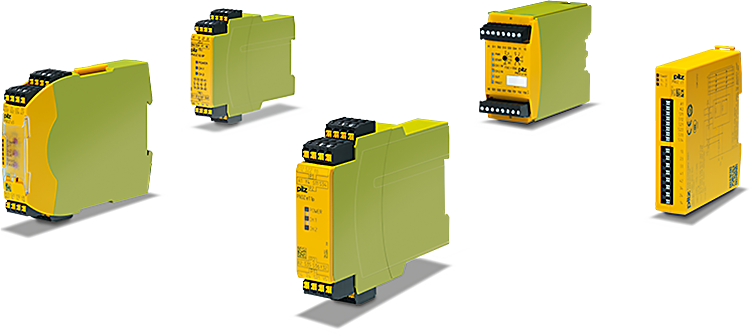- Service life: approx. 1 million operations
- At 600 - 1000 cycles per day, 300 days per year = 180,000 - 300,000 cycles per year
- Service life: 3 - 5 years
- Thereafter a HAZARDOUS SITUATION!
As a solution, Pilz launched the first compact emergency stop relay PNOZ in 1987. This gave rise to a comprehensive range of safety relays for monitoring E-STOP, safety gates, two-hand controls, light barriers, light curtains etc., which is constantly being expanded.
Defined safety functions
Safety relays can detect faults at the input contacts in the safety circuit in the event of an earth fault. The safe function is guaranteed by specific internal circuits and relay technology.
Safety relays perform defined safety functions: for example, they ensure that a movement is stopped in a controlled and therefore safe manner, the position of moveable guards is monitored and a closing movement is interrupted when there is intervention.
Find out more about the PNOZ:
Discover the new myPNOZ:
To the modular safety relay myPNOZ
Safety relays today and in the future
Safety relays are used to reduce risk: when a fault occurs and when detection zones are violated, they initiate a safe, reliable response. Safety relays are encountered in almost every area of mechanical engineering, mainly where the number of safety functions is quite manageable. However, increasing efforts are being made to integrate diagnostic information into control concepts as well as overall concepts. That's why in future, safety relays with communications interfaces will be more prevalent in plant and machinery.
Requirements of safety relay users
Safety relays have a clear structure and are simple to operate, which is why no special training measures are required. To use these devices successfully, all that's generally needed is some simple, basic electrical knowledge and some awareness of the current standards. The devices have become so widely used because of their compact design, high reliability and, importantly, the fact that the safety relays meet all the required standards. They have now become an integral component of any plant or machine on which safety functions have a role to play.
Safety relay functions
Since the first safety relays were developed - initially with the sole intention of monitoring the emergency stop function - a wide range of devices have become established which, in addition to simple monitoring functions, can also perform some very specific tasks, such as monitoring speeds or checking that voltage is disconnected on a power contactor. The devices are designed to work well with the sensors and actuators currently available on the market. Today, a safety relay is available for practically every requirement. With their diverse functionality, safety relays can implement almost any safety function, such as monitoring the entire safety chain from the sensor to the evaluation logic, through to activation of the actuator.
Differentiation between various safety relays
Today's safety relays are differentiated primarily by their technological design: from classic contact-based relay technology with electronic evaluation and contact-based volt-free outputs through to fully electronic devices with semiconductor outputs.
Common features and benefits of the various safety relays
Nothing has changed in the fundamental requirement that safety relays must always be designed in such a way that - when wired correctly - neither a fault on the device nor an external fault caused by a sensor or actuator may lead to the loss of the safety function. Technological change has advanced the development of electronic safety relays, which offer much greater customer benefits: electronic devices are non-wearing, have diagnostic capabilities and are easy to incorporate into common bus systems for control and diagnostic purposes.
3-contactor combination
The typical design of a first-generation safety relay is based on the classic three-contactor combination. The redundant design ensures that wiring errors do not lead to the loss of the safety function. Two relays (K1, K2) with positive-guided contacts provide the safe switching contacts. The two input circuits CH1 and CH2 each activate one of the two internal relays. The circuit is activated via the start relay K3. There is another monitoring circuit between the connection points Y1 and Y2 (feedback loop). This connection is used to check and monitor the position of actuators, which can be activated or shut down via the safety contacts. The device is designed to detect faults in the input circuit, for example, contact welding on an E-STOP pushbutton or on one of the output relay's safety contacts. The safety device stops the device switching back on and thereby stops the activation of relays K1 and K2.
